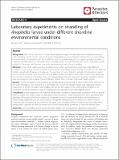| dc.contributor.author | Endo, Noriko | |
| dc.contributor.author | Kiszewski, Anthony E | |
| dc.contributor.author | Eltahir, Elfatih A. B. | |
| dc.date.accessioned | 2015-02-04T20:55:04Z | |
| dc.date.available | 2015-02-04T20:55:04Z | |
| dc.date.issued | 2015-01 | |
| dc.date.submitted | 2014-10 | |
| dc.identifier.issn | 1756-3305 | |
| dc.identifier.uri | http://hdl.handle.net/1721.1/93761 | |
| dc.description.abstract | Background
One of the concerns for future malaria epidemiology is the elevated risks of malaria around an ever-increasing number of dam sites. Controlling larval populations around reservoirs behind dams by manipulating the water levels of reservoirs could be an effective and sustainable measure for suppressing malaria epidemics; however, the effectiveness of the water-level manipulation and the contributing mechanisms have been poorly studied. In this paper, we focus on how water recession may lead to larval stranding.
Methods
Larvae of An. albimanus were studied to assess their susceptibility to stranding under different conditions representing reservoir shoreline environments in an experimental tank (50 cm × 100 cm). The tank was initially seeded with 80 larvae uniformly, and the numbers of larvae stranded on land and remaining in water were counted (summed up to recovered larvae), following the recession of water. The vertical water drawdown rate and the proportion of stranded larvae to recovered larvae (p) were measured. Shoreline conditions tested were inclinations of shore slopes (2% and 4%) and surface types (smooth, vegetated, rough, ridged).
Results
For the 2% slopes, the proportions of stranded larvae (p) increased by about 0.002, 0.004, and 0.010 as the water drawdown rate increased by a centimeter per day on the smooth, rough, and vegetated surfaces, respectively. p for the 4% slopes were smaller than for the 2% slopes. Unlike other surface conditions, no significant correlation between p and the drawdown rate was observed on the ridged surface.
Conclusions
Larger proportions of Anopheles larvae were stranded at higher water drawdown rates, on smaller reservoir slopes, and under rough or vegetated surface conditions. Three mechanisms of larval stranding were identified: falling behind shoreline recession; entrapment in small closed water bodies; and inhabitation in shallow areas. Depending on the local vectors of Anopheles mosquitoes, the conditions for their favorable breeding sites correspond to the conditions for large larval stranding. If these conditions are met, water-level manipulation could be an effective measure to control malaria along shorelines of reservoirs behind dams. | en_US |
| dc.description.sponsorship | National Science Foundation (U.S.) (Grant EAR-0946280) | en_US |
| dc.description.sponsorship | Massachusetts Institute of Technology (Cooperative Agreement between the Masdar Institute of Science and Technology (Masdar Institute), Abu Dhabi, UAE and the Massachusetts Institute of Technology (MIT), Cambridge, MA, USA--Reference 02/MI/MI/CP/11/07633/GEN/G/00) | en_US |
| dc.publisher | BioMed Central Ltd. | en_US |
| dc.relation.isversionof | http://dx.doi.org/10.1186/s13071-015-0644-5 | en_US |
| dc.rights | Creative Commons Attribution | en_US |
| dc.rights.uri | http://creativecommons.org/licenses/by/4.0 | en_US |
| dc.source | BioMed Central Ltd | en_US |
| dc.title | Laboratory experiments on stranding of Anopheles larvae under different shoreline environmental conditions | en_US |
| dc.type | Article | en_US |
| dc.identifier.citation | Endo, Noriko, Anthony E. Kiszewski, and Elfatih A. B. Eltahir. "Laboratory experiments on stranding of Anopheles larvae under different shoreline environmental conditions." Parasites & Vectors 2015, 8:38. | en_US |
| dc.contributor.department | Massachusetts Institute of Technology. Department of Civil and Environmental Engineering | en_US |
| dc.contributor.department | Parsons Laboratory for Environmental Science and Engineering (Massachusetts Institute of Technology) | en_US |
| dc.contributor.mitauthor | Endo, Noriko | en_US |
| dc.contributor.mitauthor | Eltahir, Elfatih A. B. | en_US |
| dc.relation.journal | Parasites & Vectors | en_US |
| dc.eprint.version | Final published version | en_US |
| dc.type.uri | http://purl.org/eprint/type/JournalArticle | en_US |
| eprint.status | http://purl.org/eprint/status/PeerReviewed | en_US |
| dc.date.updated | 2015-02-03T20:03:35Z | |
| dc.language.rfc3066 | en | |
| dc.rights.holder | Noriko Endo et al.; licensee BioMed Central Ltd. | |
| dspace.orderedauthors | Endo, Noriko; Kiszewski, Anthony E.; Eltahir, Elfatih A. B. | en_US |
| dc.identifier.orcid | https://orcid.org/0000-0003-4123-0489 | |
| mit.license | PUBLISHER_CC | en_US |
| mit.metadata.status | Complete | |
